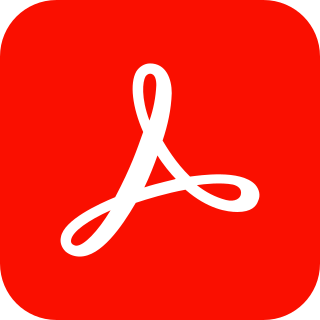
Java applets were small applications written in the Java programming language, or another programming language that compiles to Java bytecode, and delivered to users in the form of Java bytecode. The user launched the Java applet from a web page, and the applet was then executed within a Java virtual machine (JVM) in a process separate from the web browser itself. A Java applet could appear in a frame of the web page, a new application window, a program from Sun called appletviewer, or a stand-alone tool for testing applets.

Microsoft Office, or simply Office, is a family of client software, server software, and services developed by Microsoft. It was first announced by Bill Gates on August 1, 1988, at COMDEX in Las Vegas. Initially a marketing term for an office suite, the first version of Office contained Microsoft Word, Microsoft Excel, and Microsoft PowerPoint. Over the years, Office applications have grown substantially closer with shared features such as a common spell checker, Object Linking and Embedding data integration and Visual Basic for Applications scripting language. Microsoft also positions Office as a development platform for line-of-business software under the Office Business Applications brand.

Adobe Flash is, except in China, a discontinued multimedia software platform used for production of animations, rich internet applications, desktop applications, mobile apps, mobile games, and embedded web browser video players.

A website is a collection of web pages and related content that is identified by a common domain name and published on at least one web server. Websites are typically dedicated to a particular topic or purpose, such as news, education, commerce, entertainment or social networking. Hyperlinking between web pages guides the navigation of the site, which often starts with a home page. As of May 2023, the top 5 most visited websites are Google Search, YouTube, Facebook, Twitter, and Instagram.
Web design encompasses many different skills and disciplines in the production and maintenance of websites. The different areas of web design include web graphic design; user interface design ; authoring, including standardised code and proprietary software; user experience design ; and search engine optimization. Often many individuals will work in teams covering different aspects of the design process, although some designers will cover them all. The term "web design" is normally used to describe the design process relating to the front-end design of a website including writing markup. Web design partially overlaps web engineering in the broader scope of web development. Web designers are expected to have an awareness of usability and be up to date with web accessibility guidelines.

ActiveX is a deprecated software framework created by Microsoft that adapts its earlier Component Object Model (COM) and Object Linking and Embedding (OLE) technologies for content downloaded from a network, particularly from the World Wide Web. Microsoft introduced ActiveX in 1996. In principle, ActiveX is not dependent on Microsoft Windows operating systems, but in practice, most ActiveX controls only run on Windows. Most also require the client to be running on an x86-based computer because ActiveX controls contain compiled code.

Adobe Acrobat is a family of application software and Web services developed by Adobe Inc. to view, create, manipulate, print and manage Portable Document Format (PDF) files.
X3D is a set of royalty-free ISO/IEC standards for declaratively representing 3D computer graphics. X3D includes multiple graphics file formats, programming-language API definitions, and run-time specifications for both delivery and integration of interactive network-capable 3D data. X3D version 4.0 has been approved by Web3D Consortium, and is under final review by ISO/IEC as a revised International Standard (IS).

A screen reader is a form of assistive technology (AT) that renders text and image content as speech or braille output. Screen readers are essential to people who are blind, and are useful to people who are visually impaired, illiterate, or have a learning disability. Screen readers are software applications that attempt to convey what people with normal eyesight see on a display to their users via non-visual means, like text-to-speech, sound icons, or a braille device. They do this by applying a wide variety of techniques that include, for example, interacting with dedicated accessibility APIs, using various operating system features, and employing hooking techniques.
Pop-up ads or pop-ups are forms of online advertising on the World Wide Web. A pop-up is a graphical user interface (GUI) display area, usually a small window, that suddenly appears in the foreground of the visual interface. The pop-up window containing an advertisement is usually generated by JavaScript that uses cross-site scripting (XSS), sometimes with a secondary payload that uses Adobe Flash. They can also be generated by other vulnerabilities/security holes in browser security.

A dynamic web page is a web page constructed at runtime, as opposed to a static web page, delivered as it is stored. A server-side dynamic web page is a web page whose construction is controlled by an application server processing server-side scripts. In server-side scripting, parameters determine how the assembly of every new web page proceeds, and including the setting up of more client-side processing. A client-side dynamic web page processes the web page using JavaScript running in the browser as it loads. JavaScript can interact with the page via Document Object Model (DOM), to query page state and modify it. Even though a web page can be dynamic on the client-side, it can still be hosted on a static hosting service such as GitHub Pages or Amazon S3 as long as there is not any server-side code included.

Microsoft Reader is a discontinued Microsoft application for reading e-books, first released in August 2000, that used its own .LIT format. It was available for Windows computers and Pocket PC PDAs. The name was also used later for an unrelated application for reading PDF and XPS files, first released with Windows 8 - this app was discontinued in 2018.
Mobipocket SA was a French company incorporated in March 2000 that created the .mobi e-book file format and produced the Mobipocket Reader software for mobile phones, personal digital assistants (PDA) and desktop operating systems.

Microsoft Silverlight is a discontinued application framework designed for writing and running rich internet applications, similar to Adobe's runtime, Adobe Flash. While early versions of Silverlight focused on streaming media, later versions supported multimedia, graphics, and animation, and gave support to developers for CLI languages and development tools. Silverlight was one of the two application development platforms for Windows Phone, but web pages using Silverlight did not run on the Windows Phone or Windows Mobile versions of Internet Explorer, as there was no Silverlight plugin for Internet Explorer on those platforms.
The Microsoft Java Virtual Machine (MSJVM) is a discontinued proprietary Java virtual machine from Microsoft. It was first made available for Internet Explorer 3 so that users could run Java applets when browsing on the World Wide Web. It was the fastest Windows-based implementation of a Java virtual machine for the first two years after its release. Sun Microsystems, the creator of Java, sued Microsoft in October 1997 for incompletely implementing the Java 1.1 standard. It was also named in the United States v. Microsoft Corp. antitrust civil actions, as an implementation of Microsoft's "Embrace, extend and extinguish" strategy. In 2001, Microsoft settled the lawsuit with Sun and discontinued its Java implementation.
Microsoft's Chrome was the code name for a set of APIs that allowed DirectX to be easily accessed from user-space software, including HTML. Launched with some fanfare in early 1998, Chrome, and the related Chromeffects, was re-positioned several times before being canceled only a few months later in a corporate reorganization. Throughout its brief lifespan, the product was widely derided as an example of Microsoft's embrace, extend and extinguish strategy of ruining standards efforts by adding options that only ran on their platforms.










